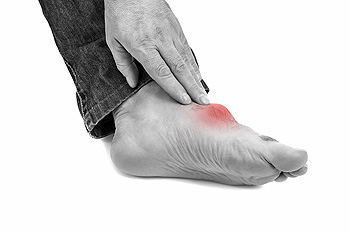How Gout Occurs
Tuesday, 07 September 2021 00:00 Uric acid is a by-product of the body breaking down purines—which are present in chemical compounds in the body as well as in certain foods we consume. Most uric acid is excreted, but when too much of it remains (hyperuricemia), it can crystalize on joints. One of the most painful arthritic conditions is known as gout. Some believe lower temperatures in the toes makes a more conducive environment for crystals to form, and so the big toe is often where gout occurs. Gout flare-ups can typically last for days or weeks before going into remission. During a flare-up, you may experience severe pain and swelling, along with heat and redness at the site. Gout with no single cause is known as primary gout. Secondary gout is due to kidney disease or medications affecting the kidney’s ability to expel urate. A podiatrist may make a diagnosis of gout after an examination, blood tests, imaging tests, and fluid aspiration from the affected joint.
Uric acid is a by-product of the body breaking down purines—which are present in chemical compounds in the body as well as in certain foods we consume. Most uric acid is excreted, but when too much of it remains (hyperuricemia), it can crystalize on joints. One of the most painful arthritic conditions is known as gout. Some believe lower temperatures in the toes makes a more conducive environment for crystals to form, and so the big toe is often where gout occurs. Gout flare-ups can typically last for days or weeks before going into remission. During a flare-up, you may experience severe pain and swelling, along with heat and redness at the site. Gout with no single cause is known as primary gout. Secondary gout is due to kidney disease or medications affecting the kidney’s ability to expel urate. A podiatrist may make a diagnosis of gout after an examination, blood tests, imaging tests, and fluid aspiration from the affected joint.
Gout is a painful condition that can be treated. If you are seeking treatment, contact Dr. Robert Graser from Graser Podiatry and Bunion Surgery Institute. Our doctor will treat your foot and ankle needs.
What Is Gout?
Gout is a form of arthritis that is characterized by sudden, severe attacks of pain, redness, and tenderness in the joints. The condition usually affects the joint at the base of the big toe. A gout attack can occur at any random time, such as the middle of the night while you are asleep.
Symptoms
- Intense Joint Pain - Usually around the large joint of your big toe, and it most severe within the first four to twelve hours
- Lingering Discomfort - Joint discomfort may last from a few days to a few weeks
- Inflammation and Redness -Affected joints may become swollen, tender, warm and red
- Limited Range of Motion - May experience a decrease in joint mobility
Risk Factors
- Genetics - If family members have gout, you’re more likely to have it
- Medications - Diuretic medications can raise uric acid levels
- Gender/Age - Gout is more common in men until the age of 60. It is believed that estrogen protects women until that point
- Diet - Eating red meat and shellfish increases your risk
- Alcohol - Having more than two alcoholic drinks per day increases your risk
- Obesity - Obese people are at a higher risk for gout
Prior to visiting your podiatrist to receive treatment for gout, there are a few things you should do beforehand. If you have gout you should write down your symptoms--including when they started and how often you experience them, important medical information you may have, and any questions you may have. Writing down these three things will help your podiatrist in assessing your specific situation so that he or she may provide the best route of treatment for you.
If you have any questions, please feel free to contact our office located in Boerne, . We offer the newest diagnostic and treatment technologies for all your foot care needs.
Featured Articles
- July 2024
- June 2024
- May 2024
- April 2024
- March 2024
- February 2024
- January 2024
- December 2023
- November 2023
- October 2023
- September 2023
- August 2023
- July 2023
- June 2023
- May 2023
- April 2023
- March 2023
- February 2023
- January 2023
- December 2022
- November 2022
- October 2022
- September 2022
- August 2022
- July 2022
- June 2022
- May 2022
- April 2022
- March 2022
- February 2022
- January 2022
- December 2021
- November 2021
- October 2021
- September 2021
- August 2021
- July 2021
- June 2021
- May 2021
- April 2021
- March 2021
- February 2021
- January 2021
- December 2020
- November 2020
- October 2020
- September 2020
- August 2020
- July 2020
- June 2020
- May 2020
- April 2020
- March 2020
- February 2020
- January 2020
- December 2019
- November 2019
- October 2019
- September 2019
- August 2019
- July 2019
- June 2019
- May 2019
- April 2019
- March 2019
- February 2019
- January 2019
- December 2018
- November 2018
- October 2018
- September 2018
- August 2018
- July 2018
- June 2018
- May 2018








